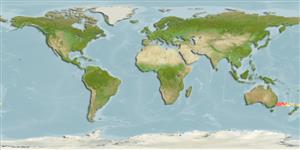>
Trachichthyiformes (Roughies) >
Trachichthyidae (Slimeheads)
Etymology: Hoplostethus: Greek, hoplon = weapon + Greek, stetho, stethion = brest; literal = to prick a little breast (Ref. 45335); melanopeza: Name from Greek 'melano' for ‘black’ and 'peza‘ for 'edge’; referring to the characteristic black edge on all fins in large individuals of this species; noun in apposition..
Environment: milieu / climate zone / depth range / distribution range
Ekologi
laut; kisaran kedalaman 250 - 400 m (Ref. 92805). Subtropical; 33°S - 37°S (Ref. 92805)
South Pacific: sub-tropical and temperate latitudes of the Tasman and South Fiji Basins; SE Australian slopes on the west to the outer Bay of Plenty and southern Kermadec Ridge at the north end of the North Island in New Zealand in the east.
Size / Weight / umur
Maturity: Lm ? range ? - ? cm
Max length : 51.5 cm SL jantan/; (Ref. 92805)
deskripsi pendek
Kunci identifiaksi (pengenalan) | Morfologi | Morfometrik
Duri punggung (Keseluruhan (total)) : 6 - 7; duri punggung lunak (Keseluruhan (total)) : 12 - 13; Duri dubur: 3; Sirip dubur lunak: 3 - 10. This species is distinguished by the following characters: 15 pectoral-fin rays, rarely 13, 14 or 16; 18-21 total gill rakers on outer side of first arch; 9-12 abdominal scutes, some scutes in large individuals with multiple apical points; 16-22 predorsal scales; isthmus lacking scales; body scales adherent; lateral–line scales with strong medial ridge, but no spine in small and medium sized adults, with strong spine centrally on posterior margin in large adults; scales on predorsal midline forming low raised ridge; body ovoid and deep, depth 1.9-2.1 in SL; nape gently curved, forehead almost straight to above upper lip; dorsal- and anal-fin spines of moderate thickness; body of adults grey, superimposed with deep red in life, outer margin of all fins with narrow black edge in adults; buccal cavity and opercular recess black, vomer, margins of mouth roof lateral to palatines, underside of tongue and upper surface of lower jaw stark white (Ref. 92805).
Inhabits continental slopes, seamounts and submarine rises with collection depths recorded between about 140 and 760 m, but most often 250-400 m (Ref. 92805).
Life cycle and mating behavior
Maturities | Reproduksi, perkembang biakan | Spawnings | Egg(s) | Fecundities | Larva
Roberts, C.D. and M.F. Gomon, 2012. A review of giant roughies of the genus Hoplostethus (Beryciformes, Trachichthyidae), with descriptions of two new Australasian species. Memoirs of Museum Victoria 69:341-354. (Ref. 92805)
Status IUCN Red List (Ref. 130435)
ancaman kepada manusia
Harmless
penggunaan manusia
Alat, peralatan
laporan khas
muat turun XML
Sumber internet
Estimates based on models
Preferred temperature (Ref.
123201): 4.3 - 9.7, mean 5.4 °C (based on 46 cells).
Phylogenetic diversity index (Ref.
82804): PD
50 = 0.5000 [Uniqueness, from 0.5 = low to 2.0 = high].
Bayesian length-weight: a=0.01660 (0.00723 - 0.03808), b=3.05 (2.85 - 3.25), in cm total length, based on LWR estimates for this (Sub)family-body shape (Ref.
93245).
Trophic level (Ref.
69278): 3.7 ±0.6 se; based on size and trophs of closest relatives
Daya lenting (Ref.
120179): sangat rendah, Waktu penggandaan populasi minimum lebih dari 14 tahun (Preliminary K or Fecundity.).
Fishing Vulnerability (Ref.
59153): Moderate to high vulnerability (45 of 100).
